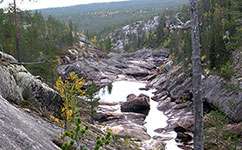Origin of Scandinavian gorges finally revealed

The deep gorges which cut across Scandinavian landscapes may have been carved by rivers flowing under ancient glaciers, say scientists.
The new evidence, published in Nature Communications, sheds light onto a long-standing debate over whether the gorges were formed when glaciers still covered the landscape, or after they melted.
The gorges had been covered by the Fennoscandian ice sheet, which at its maximum extent, stretched from Britain across northern Germany and Russia to the Barents Sea about 20,000 years ago.
The new research shows that they emerged fully formed from under the retreating ice, rather than being carved out by the rivers left following the glaciers' disappearance.
'Our results show that as the ice retreated 10,000 years ago the gorges appeared from underneath them. This implies that the gorges were formed by rivers under the ice and not by the postglacial rivers flowing through the gorges since the ice disappeared,' explains Dr John Jansen of the University of Wollongong, Australia, lead researcher on the project.
The history of the gorges has been debated for the past century, as their origin seemed to match similar gorges in Scotland that had been carved by rivers after the ice sheets above them melted.
But Jansen realised a new, powerful isotope-based method of dating the rocks might provide an answer.
To try and decipher when the gorges had formed Jansen and his team measured how much of an radioactive isotope called beryllium-10 they could find on the surfaces of the rock within them.
They hoped to find that the rocks at the base of the gorges were younger - which would prove they had slowly deepened over time. Instead the team were surprised to discover that the rock in the gorges was the same age at every place they measured.
'Nobody had tried previously to decipher these gorges using beryllium-10 exposure dating, and initially I felt disappointed in these uniform ages,' says Jansen. 'But then we really had a good think about the numbers and things started looking up. The simplest explanation for the consistency among the bedrock surface ages is that the gorges already existed when the ice retreated, and therefore must have formed by meltwater under the ice.'
Carving out a gorge under a glacier would require huge amounts of water melting and forming rivers powerful enough to both erode the bedrock and flush out debris.
'This amount of water is produced by intense surface melting and probably signifies an ice sheet in an advanced state of decay,' Jansen says.
Parts of the Greenland ice sheet undergo strong surface melting each summer, but Jansen believes the Fennoscandian ice sheet was in much worse shape at the time the gorges were formed, retreating at up to 1000m each year.
'We think that within 200 to 300 years of the inner gorges forming, the last remnants of the Fennoscandian ice sheet retreated to the Sarek Mountains in Sweden and then vanished altogether about 9900 years ago,' he explains.
More information: "Inner gorges cut by subglacial meltwater during Fennoscandian ice sheet decay." J.D. Jansen, et al. Nature Communications 5, Article number: 3815, DOI: 10.1038/ncomms4815
Journal information: Nature Communications
Provided by PlanetEarth Online
This story is republished courtesy of Planet Earth online, a free, companion website to the award-winning magazine Planet Earth published and funded by the Natural Environment Research Council (NERC).



















